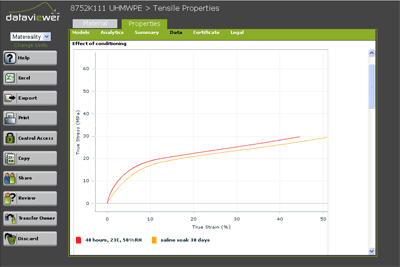|
On the conditioning of plastics prior to testing
Many commonly used plastics absorb water from the air with a consequential reduction in mechanical properties. The extent of absorption of water varies from material to material. It also increases with exposure time eventually reaching an equilibrium. In locales where the ambient humidity changes with the seasons, the moisture level in the plastic will fluctuate as water is absorbed or given off to maintain equilibrium. The mechanical properties will fluctuate correspondingly, weakening with increased moisture content.
With hydrophilic plastics such as nylon, the difference between the newly molded plastic, often called dry-as-molded (DAM) and that exposed to moisture is quite noticeable. While plastics like nylon, acetal and polyester are well known to be hydrophilic, it is interesting to note that even hydrophobic plastics like olefins can show a decrease in modulus and strength after prolonged exposure to water. Clearly if the intent is to capture in-field performance, it is important to account for this behavior in FEA.

Figure. 1 Comparing stress-strain data of DAM and moisture conditioned nylon
Choosing the correct conditioning to apply to test specimens prior to testing is an important step. If the intent is to simulate performance during or immediately after production, the DAM data is indicated. To simulate a more typical “in-field” performance, it is preferable to condition the test specimens so that they take up some moisture prior to testing. A common standards-based approach is to simply expose the test specimens at room temperature to a 50% relative humidity environment for 40 hours prior to testing. This ensures a standard moisture uptake which is based on the mass diffusion coefficient of the plastic. The test specimen typically does not reach an equilibrium moisture content but the amount of moisture uptake is the same for a given plastic.
For true "in-field" performance FEA, it may be desired to attain an equilibrated moisture level in the test specimens prior to testing. For this an understanding of the service environment is needed. For products that perform in a moisture stable environment, such as tropical or desert locales it is possible to declare the target moisture content. In locales where there is wide temporal variation in humidity level, this is not so easy and some sort of average or best case/worst case scenario must be defined. Test specimens are then subjected to moisture gain regimen to achieve the target moisture level prior to testing. Different methods are available; the specimens can simply be left in the appropriate humidity environment until they equilibrate. This can take weeks or months. Alternatively, accelerated methods can be employed that use elevated temperature and high humidity to force moisture into the test specimens at a faster pace; the process can still take days to weeks. These methods are not standardized and their effectiveness for a particular product application must be proven by alternate testing. This adds considerable complexity and cost and the resulting practice is often specific to that particular application. Additionally, since plastics are visco-elastic in nature, the stress-relaxation effects due to long term elevated temperature exposures must also be kept in mind. In most cases, this would be beneficial; however where test specimens from finished parts are being conditioned, two unassociated factors of visco-elasticity and moisture level would be simultaneously modified as a consequence of accelerated environmental exposure.
|
